Trade organizations for digital health bring stakeholders together to push the industry forward.
Digital medicine and remote care are not new, but the coronavirus pandemic has emphasized the importance of all things virtual and accelerated digital transformation. In the past few years, organizations focused on digital health and virtual care have proliferated. The Digital Therapeutics Alliance was founded in 2017, and the Digital Medicine Society was founded in 2019. And recent months have seen the launch of two new groups: the Decentralized Trials & Research Alliance and IMPACT, the virtual-first medical practice collaborative. Executives from these associations told us about the problems they’re trying to solve, the stakeholders they’re engaging, and what makes this the right time to push the industry forward.
Decentralized Trials & Research Alliance (DTRA)
An interview with Craig Lipset, Co-Chair.
What is the problem you’re trying to solve?
Decentralizing clinical research and making participation more accessible is not a new concept. Like many opportunities, however, adoption was rapidly accelerated during the pandemic as patients were unable or unwilling to consistently leave their home and travel to a clinical setting. Prior to the pandemic, most organizations had at most a handful of experiments involving decentralized clinical trials; today most organizations have a mandate to adopt. But adoption at scale remains a challenge, often due to issues that raise above any one sponsor, technology, or institution. DTRA is positioned to address the barriers to meaningful adoption of decentralized research, enabling researchers around the world to provide more options for all research participants.
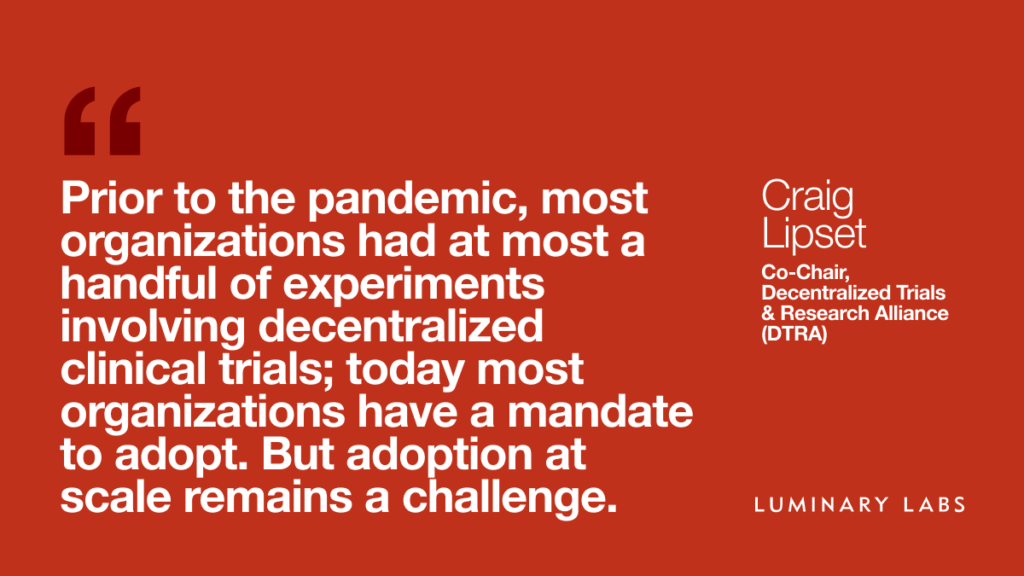
Why now?
The genesis of DTRA preceded the pandemic, and in some ways the launch was delayed as many potential members were focused on the need to adjust their portfolios of research studies during the early days of the lockdown. By late summer, most individual studies had made the adjustments necessary, and research leaders were shifting their attention to commitment — what sustaining changes are needed to mitigate risk and improve performance going forward? Meaningful adoption of decentralized research provides resilience and risk-mitigation for sponsors in an uncertain environment, while improving access, diversity, and experience for research participants. But adoption at scale is difficult for a host of reasons spanning culture, regulation, process, and technology. DTRA is an opportunity to raise all boats and set a new baseline for research conduct going forward.
Who should join and why should they be part of it?
Today, DTRA members are organizations. These include regulatory authorities, biotechnology and pharmaceutical companies, healthcare companies, CROs and other service providers, technology companies, site networks, and advocacy groups. In short, any organization able to contribute to or benefit from the adoption of decentralized research is welcome. The DTRA board is actively exploring opportunities for individual membership options for those not affiliated with a member organization. Today, interested organizations, as well as individuals, can sign up for more information at DTRA.org.
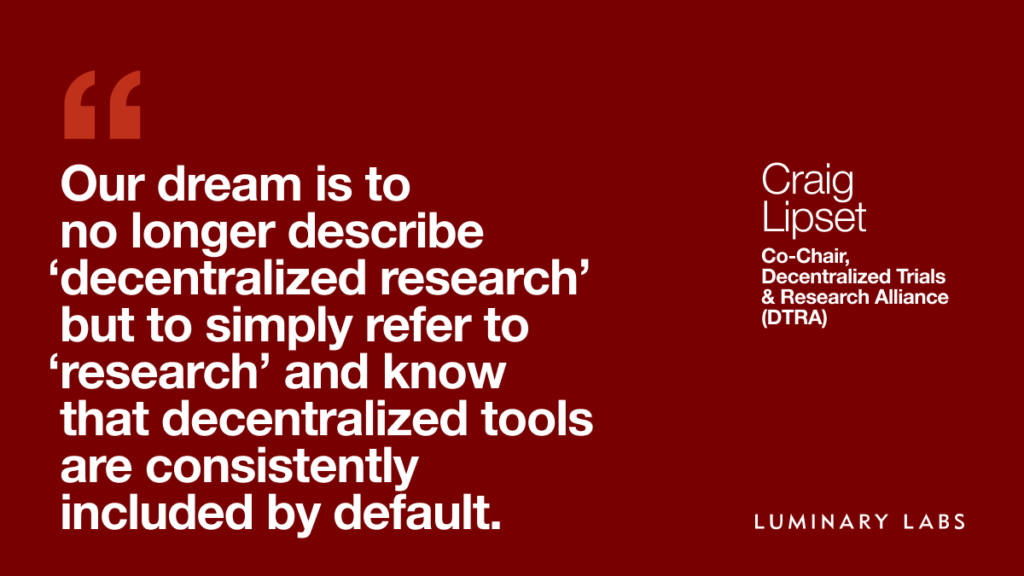
In your wildest dreams, what’s true a year from now? How will the world have changed?
Our dream is to no longer describe “decentralized research” but to simply refer to “research” and know that decentralized tools are consistently included by default. In the next year, we would like to see key global regulatory agencies share this vision, while those involved in executing studies are able to aggregate and share key performance data demonstrating the meaningful impact of decentralized research adoption.
Learn more: DTRA’s recent article in Stat provides a summary about the organization’s priorities and other goals.
Digital Medicine Society (DiMe)
An interview with Jennifer Goldsack, Executive Director.
What is the problem you’re trying to solve?
Digital technologies offer huge promise to impact some of the most pressing and persistent problems in healthcare — including poor outcomes, high cost for both society and individuals, challenges to access, health disparities, clinician burnout, and impending shortages. However, the evidence base for the safe, effective, ethical, and equitable development of digital technologies in the service of health has not kept pace with their development. Given the great divide between the promised benefits of digital medicine and its potential risks, DiMe is working to ensure that the emerging digital tools we use in the service of health are trustworthy.
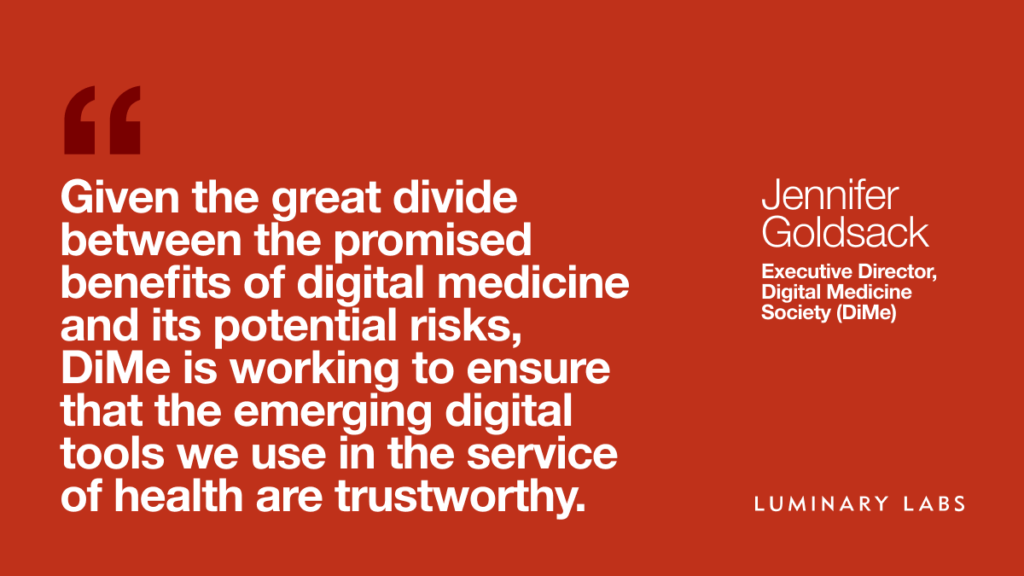
Why now?
The problems of poor outcomes, challenges in access, health disparities, affordability, clinician burnout and shortages, and devastating conditions that we simply cannot yet treat (for example, Alzheimers) are sadly not new, though the COVID-19 pandemic may be shining a light on them.
The reason to push now is that digital presents a powerful new suite of tools in the toolbox to address these challenges. More digital isn’t a better state, but solving these longstanding challenges in healthcare is. Ensuring that we harness the full capabilities of digital technologies to optimize health for everyone is critical; so is ensuring that we don’t inadvertently introduce new harms.
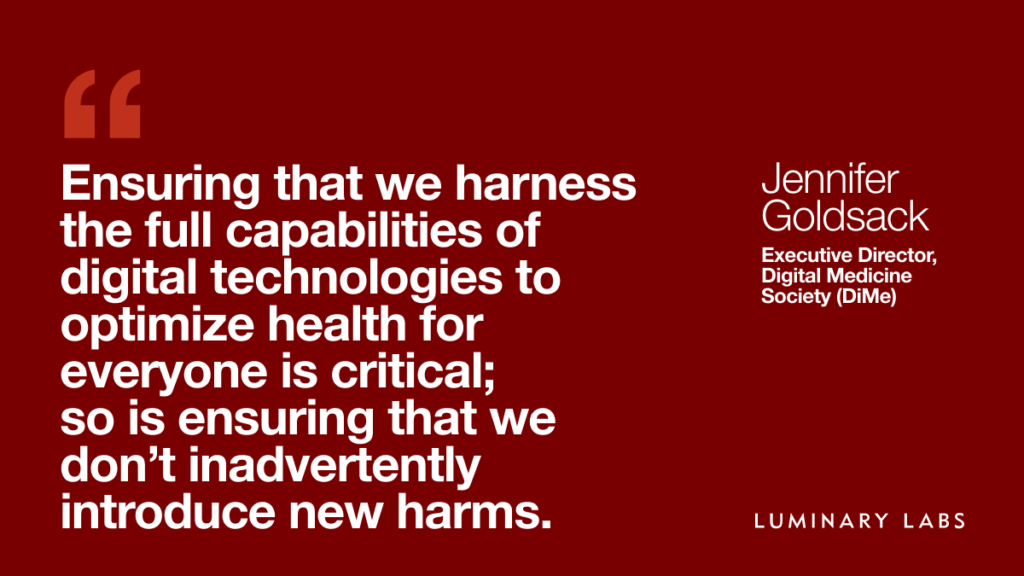
Who should join and why should they be part of it?
Any individual passionate about realizing the full promise of digital health technologies to improve lives should join. We are an inclusive community of individuals with diverse backgrounds. From regulators to white-hat hackers, ethicists to engineers, and clinicians to citizen scientists, we provide the professional home where intentional and evidence-based progress is made to ensure that digital medicine realizes its full potential to improve human health.
In your wildest dreams, what’s true a year from now? How will the world have changed?
The COVID crisis might be behind us, globally, but the lessons learned and progress made will be burned into our brains. As scientific integrity, the criticality of health equity, and collaborative approaches driving successful innovation drop out of the headlines, we must continue to push.
Learn more about DiMe’s digital endpoints library and its work on The Playbook, DiMe’s partnership with the health innovation hub of the German Federal Ministry of Health to advance global best practice with respect to evidence generation for digital health, the need to redefine patient safety in the digital era of health, and what should be in Cures 2.0 to support a transition to the digital era of healthcare. DiMe also has a federal comment toolkit to support anyone with expertise in the field who wants to lend their voice to policymaking and regulation.
IMPACT, the virtual-first medical practice collaborative
An interview with Jennifer Goldsack, Executive Director of DiMe; IMPACT is co-hosted by DiMe and the American Telemedicine Association (ATA).
What is the problem you’re trying to solve?
Virtual-first care offers the opportunity for uniquely efficient and patient-centered care, using the full suite of digital resources to build care around the patient, not the clinic. However, virtual-first care is challenged by:
- Misconceptions that virtual care is “second-class medicine,” hampering pathways to trust and reimbursement.
- Outdated regulatory and licensing models.
- The absence of an ecosystem supporting innovative, virtual-first, medical practices.
- Payer expectations for data and evidence of effectiveness.
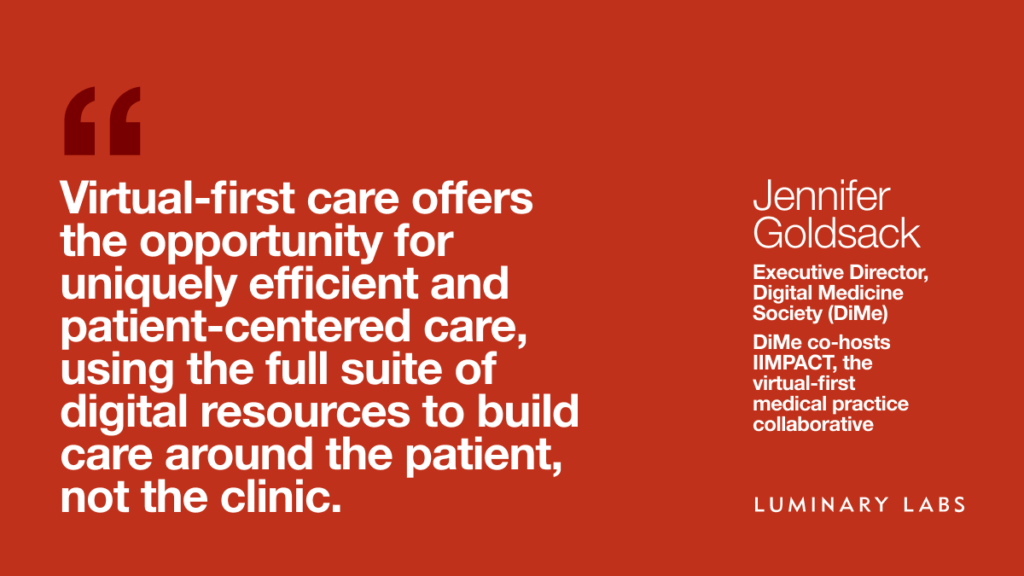
Why now?
Digital health technologies have reached a point of maturity, with high-quality digital health tools being worthy of our trust. Yet most services that we think of as telehealth have been developed to mirror traditional practice, using communications technologies to deliver an experience that aims to simulate an in-clinic visit.
In contrast, virtual-first practices have staff and clinical workflows that are based exclusively on caring for patients remotely and don’t have to be reverse-engineered into existing workflows. Virtual-first care offers an extraordinary opportunity to reimagine healthcare in the digital era.
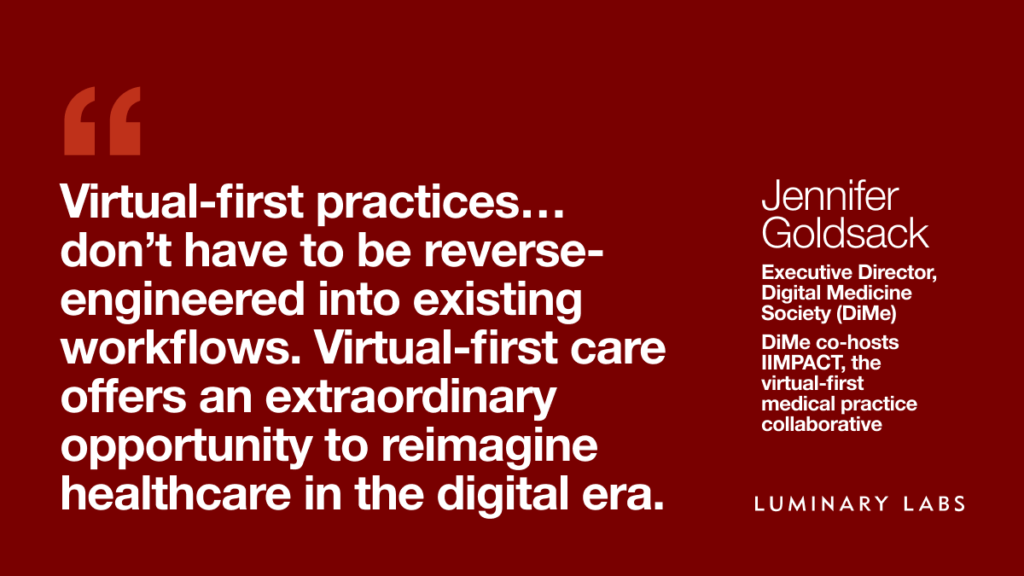
Who should join and why should they be part of it?
IMPACT aims to cultivate an ecosystem of organizations that view virtual-first care as their primary mission. From digital care organizations to payers and investors, IMPACT is an inclusive collaborative that welcomes all companies dedicated to enabling expanded access to high quality, evidence-based virtual care for patients, healthcare providers, and payers in order to improve clinical and health economic outcomes, enhance access, and provide a better overall patient experience.
In your wildest dreams, what’s true a year from now? How will the world have changed?
When was the last time you saw a job posting for a “digital marketer”? Years ago. In the same way, our audacious goal is that IMPACT has become obsolete within the year because virtual-first care has become mainstream, sitting on the continuum of care alongside traditional care approaches and clinic-based telehealth. In our wildest dreams, in a year, virtual-first care is simply digital health in practice.
Learn more: IMPACT just launched, but has plenty to share via its website and email newsletter. Anyone who is interested can subscribe to receive updates.
Digital Therapeutics Alliance (DTA)
An interview with Megan Coder, Executive Director.
What is the problem you’re trying to solve?
It is common understanding that even if two different medications come in the same color, they usually serve two different purposes. Conversely, fewer people appreciate that health products provided in a digital format also have the ability to serve very different purposes. While some digital health technologies are used for wellness, medication adherence, monitoring, or diagnosis, others use software to directly treat, manage, or prevent a disease or disorder. It is therefore the Digital Therapeutics Alliance’s (DTA) mission to help patients, clinicians, payers, and policymakers understand how to identify, assess, and utilize digital therapeutics (DTx) in everyday settings. Digital therapeutics represent a quickly advancing, evolving industry, and it is important that we work with stakeholders across the healthcare ecosystem to ensure that these products are trustworthy and globally accessible care options.
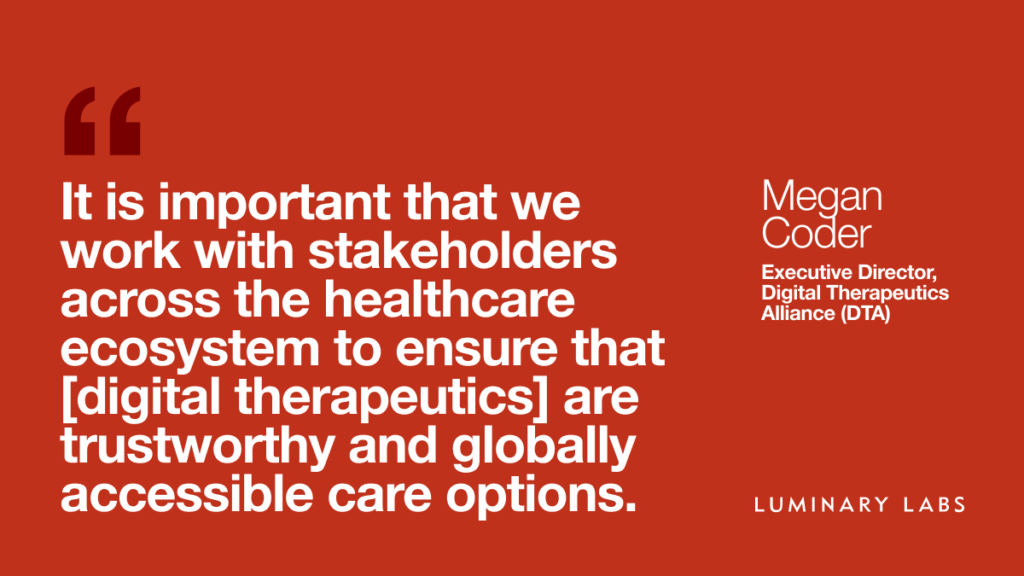
Why now?
Patients, caregivers, and clinicians faced unprecedented challenges over this past year. Given the global need to address growing mental health concerns, provide remote care for patients with chronic conditions, and enhance healthcare delivery processes, it has become critically important to address increasing gaps in care by providing patients with access to appropriate evidence-based digital therapies in their home environments. Digital therapeutics can easily reach high-risk, rural, and underserved populations who often lack access to healthcare services even during the best of times. To further enable patient access to digital therapeutics, DTA is dedicated to collaborating with policymakers to develop harmonized frameworks that properly recognize and categorize these products, with payers to develop scalable access and coverage models, and with clinicians and patients to provide much-needed education and awareness.
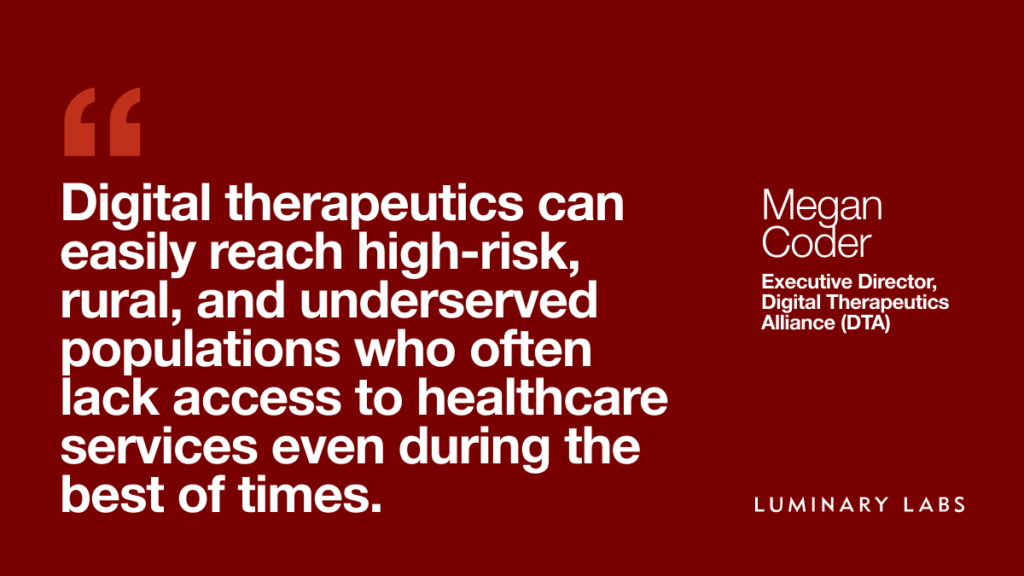
Who should join and why should they be part of it?
Organizations and companies dedicated to manufacturing and supporting clinically validated digital therapeutic products should join DTA and become part of our growing community. Member organizations have a strong voice in how policy, reimbursement, education, and awareness efforts are developed. DTA represents these leading industry perspectives as we collaborate with stakeholders to develop and implement new healthcare frameworks and models. We welcome you to join us in our mission to establish a strong foundation for this quickly growing industry.
In your wildest dreams, what’s true a year from now? How will the world have changed?
We are entering a world where clinicians have the ability to select from an arsenal of therapies — be it through a standalone or combination of medications, in-person therapy, and digital therapies — to ensure that each patient receives holistic, personalized care that delivers exactly what they need, when they need it. While clinicians and patients already receive real-time actionable insights on therapy outcomes and progression, digital therapies will increasingly develop the ability to self-optimize based on product performance and real-world outcomes. But whether this future becomes scalable for all patients a year from now, or a decade from now, depends on how well we collectively work together in 2021 and beyond.
Learn more: Last month, DTA launched a new website in order to better engage with and educate patients, clinicians, payers, and policymakers. In December 2020, DTA highlighted the many ways its members worked tirelessly in 2020 to serve the needs of patients, caregivers, and clinicians globally. And late last year, DTA released an important report about the numerous ways DTx products meet the needs of rural and underserved populations. The report highlights the challenges that individuals living in rural and underserved settings encounter, while also calling on Medicare and Medicaid to leverage evidence-based digital therapeutics to address critical gaps in care for underserved populations, regardless of whether disparities are based on patient age, language, culture, income, disease state, or geography.
Our weekly email newsletter features more updates and insights for the future-ready executive: Subscribe to the Lab Report.



